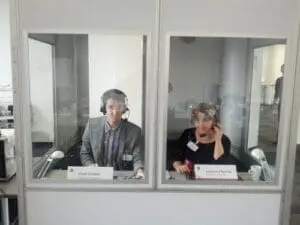
Your translators and interpreters

With simultaneous interpreting, there is no need for interruptions; the interpreters translate what has been said with a minimal delay – into several languages if necessary. The method is also called conference interpreting, for obvious reasons, but it is actually used in many contexts. Find out what types of simultaneous interpreting there are and when they are useful. Or simply tell us what you are planning; we are happy to advise you!
Simultaneous interpreters translate while the speaker is talking. They usually sit in soundproof booths and receive the sound via headphones. They simultaneously speak the translation into a microphone so that the audience can hear it through their own headphones. This technique requires the utmost concentration; therefore, two or three simultaneous interpreters always work in each language combination, taking turns every 20-30 minutes.
From the very start of the new profession, simultaneous interpreting was recognized as being one of the most exhausting things you can do with a human brain. […] A simultaneous interpreter must overrule the natural tendency not to listen when talking, and not to talk when listening. Simultaneous interpreting exists only because some very adept people can train themselves to do such an unnatural thing. […] The skill of the “conference interpreter” (the term that has come to replace oral translator, simultaneous translator, and speech translator) calls for high levels of concentration and mental agility. There are few people who can do it.
David Bellos, “Is That A Fish In Your Ear?”
When does simultaneous interpreting make sense and when should you go for a consecutive approach? Here are some aspects and scenarios to help you decide:
You are still unsure whether simultaneous interpreting is the right choice for your event? No problem – just tell us what you have in mind and we will be happy to advise you free of charge and without any commitment on your part.
If the use of an interpreter’s booth is possible, you will get the best possible results. The simultaneous interpreters sit in the soundproof booth so that they remain in the background and do not disturb or distract either the speakers or the audience. Those who need the interpretation receive it directly into their ears via headphones; the other participants are unaware of it. And using a booth also ensures the best sound quality.
Furthermore, you can have simultaneous interpreting between any number of languages; you just need a booth (and interpreters) for each language. For example, if you have an English booth and a Russian booth, a speech in German will be simultaneously interpreted into both languages. For translations between languages with no direct interpreters, so-called relay interpreting can be used: If Russian is spoken, the Russian booth interprets into German, and the English booth can use German as a bridge language and interpret it into English.
As the alternative term conference interpreting suggests, this is the standard solution for conferences, but it is also used at other major events, marketing initiatives, workshops etc.

Sometimes a booth setup is not possible. This may be due to space restrictions at the venue, or because interpreting is required while on the move. In this case, you can use a tour guide system. In this case, too, the listeners use headphones; however, the interpreters work with mobile headsets or, in specific cases, with hand-held microphones.
Since there is no booth to provide sound insulation, the interpreters have to perform a difficult balancing act: speaking loudly enough for the participants to understand them, but quietly enough not to disturb the speakers (or participants who do not need interpretation).
Here, too, the name indicates the most common application: tour guide systems are often used for guided tours or visits.
If only one person needs the interpretation, you can also fall back on chuchotage, also known as whispered interpreting. The interpreters sit directly next to the listener and whisper the translation into their ear. Of course, this also carries the risk of disturbing others. On the other hand, whispered interpreting can be easily combined with consecutive interpreting. If the listener wants to comtribute in their own language, they can do that out loud, and the interpreters will translate their words for the rest of the audience.
Further advantages are that whispered interpreting requires no equipment and that this option feels more personal for the participants than a booth.
The coronavirus pandemic has accelerated the shift to online platforms for a significant share of communication. Video is now being used for discussions, meetings, and even entire conferences. Naturally, this has also led to interpreting following suit and shifting online to some extent.
The following options are most commonly used for remote interpreting: